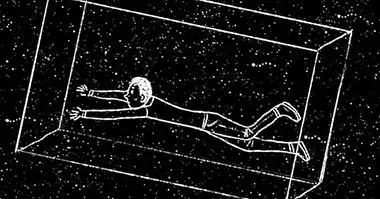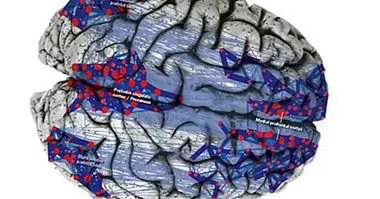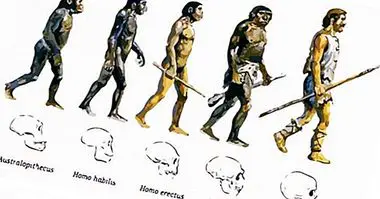Visual agnosia: the inability to understand visual stimuli
I had stopped at a florist's shop on the way to his apartment and had bought me a red rose a bit extravagant for the lapel buttonhole. I took it off and I gave it to her. He took it as a botanist or a morphologist who is given a specimen, not as a person who is given a flower.
- "About six inches in length. A red rolled shape with a green linear addition. "
-"Yes. And what do you think you are? "
- "It's not easy to say. It lacks the simple symmetry of geometric shapes, although it may have a superior symmetry of its own ... it could be an inflorescence or a flower "
P. acted exactly as a machine acts. It was not just that he showed the same indifference as a computer towards the visual world but that he constructed the world as a computer builds it, through distinctive features and schematic relationships.
Start today's entry with this excerpt from a book by Oliver Sacks ("The man who confused his wife with a hat") in which he recounts a case of visual agnosia , which leads the protagonist of the story to a disintegrated vision of the world and to different situations that, although comical, result in a serious problem of visual recognition.
Visual agnosia: definition and explanation
Being the view our main sense, always hits us and impacts read alterations of something as basic as perception. The brain, through its main window to the world -the eyes-, shows us a simple and ordered image of the world around us.
This creation that our nervous system performs is shared, to a greater or lesser extent, by almost everyone. The bases of everything we call reality are in the light that hits our retinas and travels through the optic nerve in the form of nerve impulse, to synapse in the geniculate nucleus of the thalamus-a structure that we might consider a type of brain toll in the brain. that a large number of synapses are made- until we reach our primary visual cortex in the occipital lobe. But it would be a mistake to believe that this circuit, these three synapses, are what give meaning to the world in which we live. What makes us not live in a chaotic or fragmented world, as in the case of P., is the function of gnosis.
Gnosis, from Latin knowledge, refers to the ability to recognize objects, people, faces, spaces, etc. In addition, it is also the faculty that offers us a global and united perception of reality and not schematic or "in parts". So, the visual agnosia is the loss of this ability . To better understand this process we will talk about the two main cerebral pathways that participate in this function. We will also talk about the types of agnosia most frequently described in the biographies
Visual perception: the way of what and where
As we said, the information of the retina reaches our primary visual cortex after having synapsed in the thalamus. But the primary visual cortex is not informative in itself as far as recognition is concerned. It only processes the physical characteristics of what the retina perceives. That is: light, contrast, visual field, visual acuity, etc.
Thus, the primary visual cortex, area 17 of Brodman, only possesses raw information. It does not tell us that we see a nice sunset or a dry leaf. So, What will it mean to recognize an object?
Recognizing objects, faces, places ...
First, we must be able to see the object in question, making those three synapses in order to capture the physical information of the light that first hits the object and then in our retina. Secondly, d We must integrate all this information to perceive it as a whole . Finally, we will have to rescue from our memory the memory of that object already present in our memories and its name.
As we can see, this implies more than one source of information. In the brain, the cortex that is in charge of relating different types of information is called associative cortex. To perform the steps we have described, we will need associative cortex. Thus, the brain will need more synapses, and this will be when the ways of what and where come into play.
ID
The way of what, or ventrally, is directed towards the temporal lobe and is responsible for the recognition and identification of objects . It is the way, if for example we see in the middle of the desert a green thing, big and with thorns helps us to identify it as a cactus and not as a Hulk.
It is not surprising that this path is located in the temporal lobe if we think that it is the main one in charge of memory functions. Therefore the way of what they are nervous projections that unite the information of our retina with that of our memory. It is the synthesis of optical and limbic information.
Location
The way of where, or dorsal pathway, is projected to the parietal lobe. AND s the path responsible for locating objects in space ; perceive their movement and trajectory, and relate their location among them. Therefore, it is the way that allows us to direct our movements efficiently in a given space.
They are the neurons that allow us to follow with the view the direction taken by a tennis ball that is hit from one field to another. It is also the way that allows us to write a letter to a mailbox without making mistakes.
Different neurological disorders - infarcts, traumatic brain injuries, infections, tumors, etc. - may affect these pathways with expected deficits depending on the affected region. As usual, these brain regions will not only be affected if their cortex is damaged, but also if the fibers connecting these areas with the primary visual cortex are affected.

Perceptive visual agnosia
In this type of agnosia components of perception fail, and therefore, there is no recognition . Perception is the faculty that integrates the physical characteristics of an object so that we can capture them as a three-dimensional whole.
In the apperceptive visual agnosia this integration is severely affected and the patient shows deficits even in the recognition of the simplest forms. These patients, before the drawing of a hammer will not know how to recognize it as a hammer. Neither will they know how to copy it or pair it with another drawing of the same hammer. In spite of everything, the visual acuity is normal, as well as the perception of light, darkness, etc. In fact, patients can even avoid obstacles when they walk. However, the consequences for the patient are so nefarious that functionally they tend to be almost blind with serious problems in their level of independence.
Some authors, in a very opportune way, have paraphrased Saramago "there are blind people who do not see, and blind people who do not see". The case of a patient with apperceptive agnosia would be the second. These patients can recognize the object by means of another sensory modality such as touch-sometimes touching the different parts of the object in question-or with contextual clues or descriptions of the examiner. In addition, this type of actions by the examiner help to make a differential diagnosis and rule out that the anomie - inability to say the name of what is seen - is not due to a language deficit, for example.
It is a rare type of agnosia and has been described more frequently after bilateral infarcts of the regions of the posterior arteries, intoxications by carbon monoxide and in the later variant of Alzheimer's disease. So, s e produced by pathologies that affect occipitotemporal regions .
Associative visual agnosia
In this type of agnosia, in addition to visual acuity, perception of color, light, contrast ... the perception is also preserved . However, despite a normal perception, recognition is affected. As in the previous case, before the drawing of a hammer the subject will not know that it is a hammer, but in this case it will be able to match it with another drawing of a hammer. You can even copy the drawing or describe the object.
It is possible that they identify the drawing due to one of the details of the represented object. As a general rule, the objects are more difficult to identify than the real ones , possibly due to a contextual factor. Again the rest of sensory modalities can help its recognition.
Associative agnosia it seems to be due to the disconnection between the visual and limbic systems . The substrate can be the bilateral lesion of the white matter (inferior longitudinal fasciculus) from the occipital associative cortex to the middle temporal lobe, which involves a disconnection of the visual and memory systems. That is why this agnosia is also called amnesic agnosia. The causes are similar to the case of apperceptive agnosia.
Other types of agnosia
There are many more types of agnosia and disorders of perception . I will quote some of them below. I'm just going to make a small definition to identify the disorder,
Achromatopsia
It is the inability to distinguish colors. Patients who suffer from it see the world in gray tones. A bilateral lesion of the occipitotemporal region appears secondarily. There are very few registered cases. If the lesion is unilateral it will not cause symptoms. I highly recommend the reading of "Anthropologist on Mars" which tells the story of a case of achromatopsia. Also, reading Oliver Sacks is always a pleasure. I show you a fragment of this case which will be much more explanatory of the disorder than my definition:
"Mr. I.he could barely stand the way people now looked ("like gray and animated statues"), and he could not stand his own appearance in the mirror: he avoided social life, and sexual intercourse seemed impossible to him: he saw the flesh of people, the flesh of his wife, his own flesh, an abominable gray; the "flesh color" seemed "rat color" [. . .] I found the meals unpleasant due to its dull, grayish appearance, and I had to close my eyes to eat "Prosopagnosia
It is the inability to recognize familiar faces, famous people previously known or even the face of oneself in the mirror .
The prosopagnosia is a specific deficit of the recognition of faces and, therefore, we must discard other types of agnosias for its diagnosis. In general, other functions such as reading are not affected. They can also estimate whether they are human or primate faces and even recognize the emotional expression of the face in question. It should be noted that deficits are more evident when photographs are recognized than when the person in question is seen, since there will be other contextual clues such as the movement of the person. It is also very interesting the proposal of Damasio et al (1990) that would consider that prosopagnosia would not be so much a failure in the recognition of faces, but rather the inability to identify the individuality within a set of similar ones.
Acinetopsia
It is the inability to perceive objects in movements . It is frequently due to posterior occipitoparietal lesions. The first case of acinetopsia was described in 1983 in a 43-year-old woman who had suffered several bilateral cerebrovascular infarcts. The deficits seriously affected his level of independence. For example, I needed to touch the edge of the cup to know when I should serve coffee.
Some conclusions
I think it is not necessary to justify how basic the gnosis function is for our lives. In a way, our consciousness depends on what we see and the reality that makes up our brain . This "reality", manufactured by our circuits, possibly is far from what reality is as such. Let's think for a moment: when we see how someone speaks, we generally see what we see and what we hear has a synchronicity. That is to say, if a friend speaks to us we should not see that he first moves his mouth and then we hear the sound, as if it were a badly folded film. But, on the other hand, the speed of light and the speed of sound are very different.
The brain, in a way, integrates reality so that we understand it in an orderly and logical way . When this evil Cartesian genius fails the world can acquire a chaotic and aberrant tone. Like the fragmented world of P. or the absent world of color of I. But is your world more unreal than ours? I think not, we all somehow live cheated by our brain. As if we were in The Matrix. A Matrix created by ourselves.
Patients like P. or I. have contracted pathologies that have made them move away from the "reality" that we are used to sharing with other human beings. Although these specific cases had happy endings characterized by personal improvement, in the usual tone of Oliver Sacks, it should be noted that not all cases are equally beautiful. Neurologists and neuropsychologists only see clinical manifestations of these pathologies and, unfortunately, in many cases in these cases we are forced to adopt a "voyeur" attitude. That is to say, many times we can not do much more than follow the case and see how it evolves .
Currently, pharmacological therapies for neurodegenerative disorders are of very limited use. Science must develop new drugs. But neuropsychologists must develop new non-pharmacological therapies beyond classical cognitive stimulation. In this, centers such as the Guttmann Institute, specialists in neurorehabilitation, are making great efforts and dedication. My subjective opinion is that perhaps new virtual reality therapies will mark the 21st century of neuropsychology. In any case we must work on this or other options and not be satisfied with the diagnosis only.
Text edited and edited by Frederic Muniente PeixBibliographic references:
Books that narrate cases of Agnosia and that I highly recommend reading:
- Luriia, A., Lemos Giráldez, S., & Fernández-Valdés Roig-Gironella, J. (2010). Lost and recovered world. Oviedo: Krk Editions.
- Sacks, O. (2010). The man who confused his wife with a hat. Barcelona: Anagram.
- Sacks, O. An anthropologist on Mars. Barcelona: Anagram
Textbooks:
- Arnedo A, Bembire J, Tiviño M (2012). Neuropsychology through clinical cases. Madrid: Panamericana Medical Publishing House.
- Junqué C (2014). Manual of Neuropsychology. Barcelona: Synthesis
Articles:
- Álvarez, R. & Masjuan, J. (2016). Visual agnosias. Revista Clínica Española, 216 (2), 85-91. //dx.doi.org/10.1016/j.rce.2015.07.009
I highly recommend this article above. It is very well explained and is very clear and concise.
- Barton, J. (1998). Higher cortical visual function.Current Opinion In Ophthalmology, 9 (6), 40-45. //dx.doi.org/10.1097/00055735-199812000-00007
- Barton, J., Hanif, H., & Ashraf, S. (2009). Relating visual to verbal semantic knowledge: the evaluation of object recognition in prosopagnosia. Brain, 132 (12), 3456-3466. //dx.doi.org/10.1093/brain/awp252
- Bouvier, S. (2005). Behavioral Deficits and Cortical Damage Loci in Cerebral Achromatopsia. Cerebral Cortex, 16 (2), 183-191. //dx.doi.org/10.1093/cercor/bhi096
- Naccache, L. (2015). Visual consciousness explained by its impairments. Current Opinion In Neurology, 28 (1), 45-50. //dx.doi.org/10.1097/wco.0000000000000158
- Riddoch, M. (1990). M.J. Farah, Visual agnosia: Disorders of object recognition and what they tell us about normal vision. Biological Psychology, 31 (3), 299-303. //dx.doi.org/10.1016/0301-0511(90)90068-8
- Zeki, S. (1991). Cerebral Akinetopsia A Review.Brain, 114 (4), 2021-2021. //dx.doi.org/10.1093/brain/114.4.2021



















